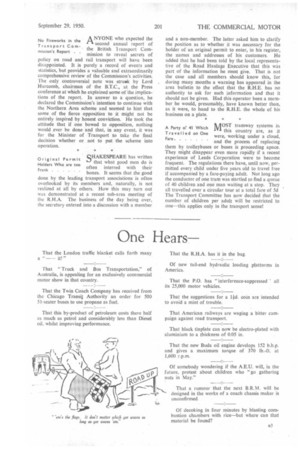Passing Comments
Page 36

Page 37

If you've noticed an error in this article please click here to report it so we can fix it.
New Redford Models THE new big Bedford Had Four Years Hard 7-tonner, or, in articulated Test form, 10-tonner, owes much of its final design to a most rigorous system of testing both here and abroad. Both as a standard lorry and tipper, the unladen weight is under 3 tons, and only the elimination of weak points in prototypes over a trial period of years permitted this low weight to be combined with the qualities of long life and reliability. A special rough-track test course was built, this being studded with concrete blocks up to 2 ins, high, so arranged and spaced that wheels could not avoid them. For four years prototypes circled this track, which has a severity ratio of 100 to 1 compared with normal rQads. In addition, the vehicles covered over 500,000 miles on road duration tests, partly on the West African Gold Coast to check cooling and cab comfort. We understand that these severe tests resulted in 80 per cent, of certain prototypes being changed in some respect, i.e., only 20 per cent. remained to the original specification.
Will the Next Triplex QTOCKHOLDERS w h o
Move be Cabaret " attend the annual general
Turns ? meetings of the Triplex concern usually find something novel. At this week's meeting, the lights were lowered and appropriate coloured lantern slides. accompanied by a recorded commentary in Sir rt,
Graham Cunningham's voice, were shown. Light music was played before and after the meeting. Sir Graham told those present that under the company's profit-sharing scheme the employees are receiving £29,098, compared with £12,687 in the previous year, also that a pension fund and life-assurance scheme has been established for them. To obtain this, the employees have agreed to halve their share of profits in future years.
Encouraging Use of IT is claimed by the Radio Television Interfer• 1 Industry Council that 85 per ence Suppressors . centof interference with
television is caused by the ignition systems of motor vehicles, and even in oilengined vehicles by screen-wiper motors of the heavy commercial type. The Lucas concern is not only supplying suitable suppressors for both possible sources of trouble, but also transparencies bearing the words "This Car is Suppressed." (We trust that this will not be taken to indicate also the condition of the occupants.) These suppressors are cheap, and easily fitted, but, in addition, the company is producing a new distributor in which a suppression device is "built in." Suppressors of high quality are claimed to increase the life of sparking plugs, as the initial oscillatory current is damped and the spark "capacity component" reduced to a fraction of an amp Demonstrations of this equipment are being given at the Commercial Motor Show and will be continued at the Motor Show.
A NYONE who expected the 1-k second annual report of mission's. Report . .• toe British Transport Com mission to reveal secrets of policy on road and rail transport will have been disappointed. It is purely a record. of -events and statistics, but provides a valuable and extraordinarily comprehensive review of the Commission's activities. The only controversial note was struok by Lord Hurcomb, chairman of the B.T.C., at the Press conference at which he explained some of the implications of the report. In answer to a question, he declared the Commission's intention to continue with the Northern Area scheme and seemed to hint that some of the fierce opposition to it might not be entirely inspired by honest conviction. He took the attitude that if one bowed to opposition, nothing would ever be done and that, in any event, it was for the Minister of Transport to take the final decision whether or not to put the scheme into operation.
SHAKESPEARE has written that what good men do is often interred with their bones. It seems that the good done by the leading transport associations is often overlooked by its members and, naturally, is not realized at all by others. How this may turn out was demonstrated at a recent sub-area meeting of the R.H.A. The business of the day being over, the secretary entered into a discussion with a member
Original Permit Holders Who are too Frank
and a non-member. The latter asked him to clarify the position as to whether it was necessary for the holder of an original permit to enter, in his register, the names and addresses of his customers. He added that he had been told by the local representative of the Road Haulage Executive that this was part of the information he must give. That is not the case and all members should know this, for during many months a warning has appeared in the area bulletin to the effect that the R.H.E. has no authority to ask for such information and that it should not be given. Had this operator been a member he would, presumably, have known better than, as it were, to hand to the R.H.E. the whole of his business on a plate.
MOST tramway systems in Iv-t this country are, as it were, working under a cloud, and the process of replacing them by trolleybuses or buses is proceeding apace. They might disappear even more rapidly if a recent experience of Leeds Corporation were to become frequent. The regulations there have, until now, permitted every child under five years old to travel free if accompanied by a fare-paying adult. Not long ago the conductor of one tram was startled to find a queue of 40 children and one man waiting at a stop. They all travelled over a circular tour at a total fare of 5d The Transport Committee has now decided that the number of children per adult will be restricted to one—this applies only in the transport sense!
A Party of' 41 Which Travelled on One
Fare




























































































